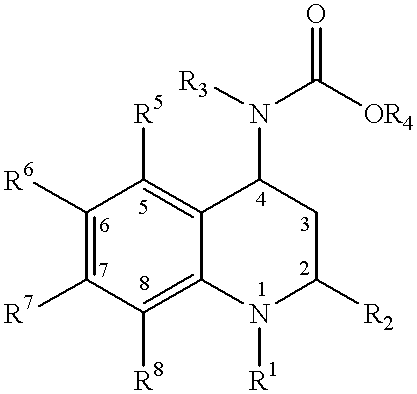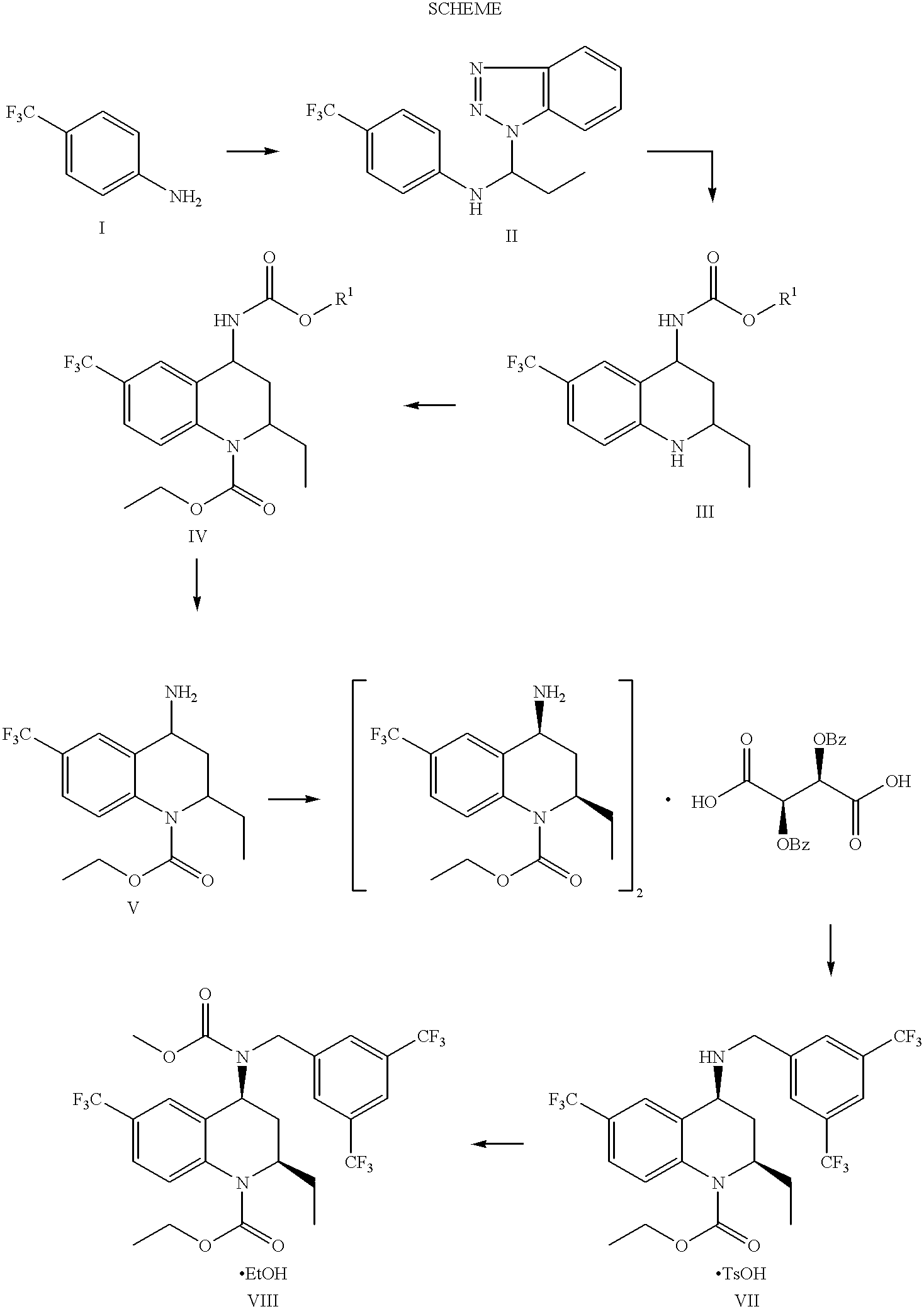Method for making 4-carboxyamino-2-substituted-1,2,3,4-tetrahydroquinoline
a technology of hdl-cholesterol and substituted tetrahydroquinoline, which is applied in the field of making 4carboxyamino-2 substituted1, 2, 3, 4tetrahydroquinoline, can solve the problems of reducing compliance, no wholly satisfactory hdl-elevating therapy exists, and high levels of hdl-cholesterol negatively correlated with the risk of cardiovascular diseases, etc., to achieve high purity of formula vii compound, easy scal
- Summary
- Abstract
- Description
- Claims
- Application Information
AI Technical Summary
Benefits of technology
Problems solved by technology
Method used
Image
Examples
example 1
(1-Benzotriazol-1-yl-propyl)-(4-trifluoromethyl-phenyl)-amine
A two liter, four neck flask under nitrogen atmosphere was charged with benzotriazole (36.96 g, 310 mmol, 1.0 equiv) and dry toluene (400 mL). A room temperature solution of 4-(trifluoromethyl)aniline (39.1 mL, 310 mmol, 1.0 equiv) and 50 mL toluene was added over one minute. A room temperature solution of propionaldehyde (24.6 mL, 341 mmol, 1.1 equiv) and 50 mL toluene was then added over 20 minutes. There was an exotherm from 23.degree. C. to 30.degree. C. during this addition. After stirring 24 h, n-heptane (500 mL) was added, and the slurry stirred an additional 1 h. The suspension was filtered, the solids were washed with n-heptane (1.times.100 mL, then 1.times.200 mL, and dried. (1-Benzotriazol-1-yl-propyl)-(4-trifluoromethyl-phenyl)-amine was isolated as shiny white needles (81.3 g, 82%). After 24 h, a second crop was isolated from the filtrate (8.7 g, 9%). mp 130-132.degree. C.; .sup.1 H NMR (DMSO-d6, 400 MHz) .del...
example 2
cis-(2-Ethyl-6-trifluoromethyl-1,2,3,4-tetrahydro-quinolin-4-yl)-carbamic acid benzyl ester
A one liter, four neck flask under nitrogen atmosphere was charged with N-vinyl-carbamic acid benzyl ester (27.66 g, 156 mmol, 1.0 equiv) and dry toluene (500 mL). (1-Benzotriazol-1-yl-propyl)-(4-trifluoromethyl-phenyl)-amine (50.0 g, 156 mmol, 1.0 equiv) and p-toluenesulfonic acid monohydrate (297 mg, 1.56 mmol, 0.01 equiv) were added, and the mixture heated to 70.degree. C. After 2 h, the mixture was cooled to room temperature and transferred to a separatory funnel. Ethyl acetate (500 mL) was added. The mixture was washed 1.times.200 mL 1 N NaOH, 1.times.200 mL H.sub.2 O, 1.times.200 mL brine, and dried (MgSO.sub.4). The mixture was filtered and the solids washed 1.times.50 mL ethyl acetate. The filtrate was concentrated to approximately 250 mL. 500 mL toluene were added, and the mixture concentrated to approximately 500 mL. 500 mL n-heptane were added, the slurry was stirred 1 h, filtered t...
example 3
cis4-Benzyloxycarbonyiamino-2-ethyl-6-trifluoromethyl-3,4-dihydro-2H-quinol ine-1-carboxylic acid ethyl ester
A three liter, four neck flask under nitrogen atmosphere was charged with cis-(2-ethyl-6-trifluoromethyl-1,2,3,4-tetrahydro-quinolin-4-yl)arbamic acid benzyl ester (96.0 g, 254 mmol, 1.0 equiv), dry dichloromethane (720 mL), and dry pyridine (103 mL, 1.27 mol, 5.0 equiv). A solution of ethyl chloroformate (121 mL, 1.27 mol, 5.0 equiv), in dry dichloromethane (240 mL), was added slowly over 4 h. The addition was exothermic and required a reflux condenser. Once the chloroformate addition was complete, the reaction was cooled in an ice bath and 1350 mL 1N NaOH were added. The mixture was stirred 15 min, then transferred to a separatory funnel. The layers were separated and the aqueous extracted 1.times.1L dichloromethane. The combined dichloromethane layers were washed 1.times.1350 mL 1N HCl, 1.times.1L saturated aq. NaHCO.sub.3, 1.times.1L brine, and dried (Na.sub.2 SO.sub.4). ...
PUM
| Property | Measurement | Unit |
|---|---|---|
| Time | aaaaa | aaaaa |
| Angle | aaaaa | aaaaa |
| Angle | aaaaa | aaaaa |
Abstract
Description
Claims
Application Information
 Login to View More
Login to View More - R&D Engineer
- R&D Manager
- IP Professional
- Industry Leading Data Capabilities
- Powerful AI technology
- Patent DNA Extraction
Browse by: Latest US Patents, China's latest patents, Technical Efficacy Thesaurus, Application Domain, Technology Topic, Popular Technical Reports.
© 2024 PatSnap. All rights reserved.Legal|Privacy policy|Modern Slavery Act Transparency Statement|Sitemap|About US| Contact US: help@patsnap.com









